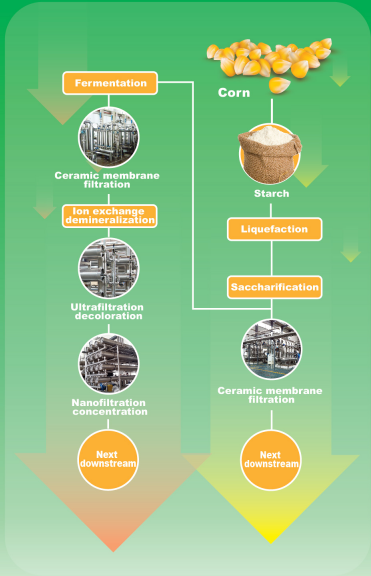Fructose corn syrup is also called High Fructose CornSyrulas, referred to as HFCS. It is made of starch as raw material, chemically or enzymatically produced into glucose, and then isomerized by glucose isomerase into fructose and Mixed syrup of glucose. It has high solubility, good chemical and thermal stability, high osmotic pressure, moisture absorption and moisture retention, and is a common sweetener in the food processing industry.
In the corn starch production process of glucose, most of the enzyme conversion process is adopted. The material liquid of starch hydrolysis to produce syrup contains a lot of insoluble impurities such as fat, starch, protein, and fiber. If these impurities cannot be effectively removed, the impact will be slight the quality, and purity of the product will cause pollution and cause the product to be scrapped.
Traditional syrup clarification and filtration usually use solid-liquid separation equipment such as plates and frames, vacuum drums, centrifuges, and diatomaceous earth machines. However, these methods cannot effectively separate the large amounts of soluble proteins, colloids, impurity polysaccharides, and submicron particles in the syrup. The light transmittance of the filtrate is very low, and the residual substances can be used for the extraction of subsequent processes and the quality of the final product. The yield has a great impact; at the same time, the traditional process has many shortcomings, such as many steps, large water consumption, high labor intensity, and high waste water discharge and concentration.
Ceramic membrane separation technology is a "cross-flow filtration" process, with ceramic membrane elements as the core. The ceramic membrane with a separation accuracy of 2-200nm is used to clarify and filter the sugar liquid, which can intercept and remove suspended solids, particles and molecular weight in the sugar liquid. Larger soluble impurities such as colloids, fibers, starch, realize the high-precision filtration of sugar liquid, and the filtrate has high transparency and high purity. Since the mud, starch, macromolecular protein, colloid, fiber, bacteria, etc. in the sugar solution are mostly filtered out by the ceramic membrane, this greatly reduces the pollution of the subsequent resin, increases the service life of the resin, and prolongs the regeneration cycle of the resin. At the same time, due to the reduction of chromaticity impurities in the filtrate, the addition of activated carbon for subsequent decolorization is also reduced or even eliminated.

The membrane technology solution provided by Jiuwu Hi-Tech has the following remarkable features:
1. High separation accuracy and high light transmittance of filtrate. It ensures that impurities in the sugar solution cannot easily penetrate the ceramic membrane, and the retention rate of insoluble suspended matter, and impurities, reaches more than 99%.
2. Compared with the traditional vacuum drum filter and diatomaceous earth filter, most of the existing mud, starch, macromolecular protein, colloid, fiber, and bacteria are filtered out of the filtered sugar liquid after the inorganic membrane filtration, which reduce the pollution of subsequent ion exchange resin, increase the service life of the resin, and extend the regeneration cycle of the resin; at the same time, due to the reduction of chromaticity impurities in the filtrate, the amount of subsequent decolorizing activated carbon added is also reduced or even eliminated.
3. No need to add additives, no waste discharge, safety and sanitation, it is a green and environmentally friendly technology. There is no need for additional additives such as diatomaceous earth for pre-coating and flocculation. The filter residue after filtration is non-polluting and contains high protein, which can be returned to the process for application or as feed processing or organic fertilizer recycling.
4. The membrane element has excellent acid and alkali resistance, and the membrane has a long service life. Compared with the organic polymer filter membrane, the high-temperature sintered inorganic membrane has a rigid porous structure and is inert when in contact with acid and alkali, avoiding the use of polymer filter The membrane holes that exist in the membrane are easy to compress and deform, difficult to clean and regenerate. It needs expensive cleaning agents, the membrane is not resistant to abrasion and easy to damage, the reliability, the concentration ratio, and the yield are not high, the service life is short, and the membrane replacement cost is high.
5. The product yield is improved. The membrane filtration process is a dynamic cross-flow membrane filtration process, so it is impossible to have a high solid content of the filter residue like plate and frame filtration and centrifugal filtration. This process can collect the effective ingredients in the filter residue and improve the product Yield.
6. Through the optimization of the membrane operation process, the amount of wastewater generated during the operation of the membrane system is greatly reduced; at the same time, due to the high-precision filtration of the inorganic membrane, the impurities in the filtrate are reduced, so that the amount of wastewater generated during subsequent ion exchange resin regeneration and COD/BOD is greatly reduced, and no additional waste (no diatomaceous earth mud) is discharged, thereby greatly reducing environmental protection pressure.
The application of ceramic membrane technology in the production process of high fructose syrup has achieved significant economic benefits and is being accepted and applied by more and more food additive manufacturers.




 +86-25-58849045
+86-25-58849045
 +86-25-58749295
+86-25-58749295
 jiuwu@jiuwu.com
jiuwu@jiuwu.com
 No. 9 Park Road, Pukou District, Nanjing City (Sanqiao Factory)
No. 9 Park Road, Pukou District, Nanjing City (Sanqiao Factory) Call us on:
Call us on:  Email Us:
Email Us:  No. 9 Park Road, Pukou District, Nanjing City (Sanqiao Factory)
No. 9 Park Road, Pukou District, Nanjing City (Sanqiao Factory)

 English
English 한국어
한국어 français
français русский
русский Español
Español

